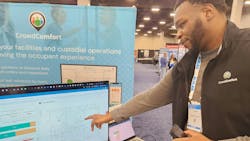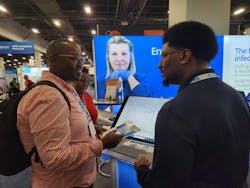How Software Solutions Can Drive Savings in Facility Cleaning (ISSA 2024)
Software solutions aren’t just for energy management or water metering—they can help optimize cleaning operations too. At the 2024 ISSA Show North America, vendors showcased software packages that promise cost savings in all aspects of cleaning.
Different software will have different features, so it’s important to shop around and make sure you’re specifying a product that will work for your facility. ISSA vendors highlighted these three software features that can help you find and act on hidden sources of wasted spending.
1. Staffing Levels
Cleaning and housekeeping software solutions can help you understand where you need more or less cleaning, which can translate into right-sizing the number of people you have on-site to clean. Smart Facility Software, which has been developing software for about 30 years, showcased several software products at the ISSA show this year; one of them, ES Optimizer, calculates your full-time equivalent employee needs according to your standards, budget, and goals. It factors in considerations like the estimated cleaning time of different space types, determines your staffing needs, and then helps you assign work based on that calculation.
The company’s suite of products is scalable, so if you need more capabilities than just the staffing analysis, you can invest in other modules covering things like surveying to ensure cleaning standards have been met. “No more paper and data re-entry with taking surveys,” said Jodie Mowrey, director of marketing and communications for Smart Facility Software. “Everything we have on desktop is on mobile as well.”
2. Acting on Requests
The ability to quickly respond to needs for restroom supplies is critical. If a restroom is out of toilet paper, someone needs to know about it—and soon. CrowdComfort, a real estate technology platform showcased on the show floor, geolocates where people are in your building and what they need in the space. It’s not limited to servicing restrooms—it can be used for all sorts of requests, explained Eric Graham, CrowdComfort founder and CEO.
“If you’re an employee in a large organization and you’re in a conference room or bathroom, there are different things you need in those places,” Graham said. “It might be a piece of AV equipment that’s stopped working, or it’s not clean, or the temperature is too hot or cold. We would route that information directly to different teams based on where you are, what room you’re in, what building, and who can respond.” The IT department might respond to your AV request, for example, while your housekeeping team would take care of any unclean areas your occupants noticed. At the end of the process, users can rate their experience so you know that your teams did a good job.
3. Accountability
Are your teams performing the tasks they’re supposed to? The old clipboard with a paper checklist won’t cut it when it comes to accountability and tracking what’s been done. Taqt Americas showcased several easy-to-use solutions at the show, including a rating system for end users, who can simply wave a finger over one of a series of smiley faces indicating the user’s satisfaction with the room’s cleanliness.
“We’re trying to connect the back-end staff with the users of the buildings to enhance their experience and optimize staff operations by understanding where they need to be and when they need to be there,” said CEO Jason Hish. “Each device has NFC, which gives the ability for staff members even without a smartphone to check into each device, so you can monitor the response times and satisfaction levels as well.”
The wireless devices don’t touch IT infrastructure, making them simple to install and avoiding cybersecurity risks, Hish added.
It can be easy to become overwhelmed by the amount of data generated by different building systems, but the right system will help you interpret the incoming information so you can make decisions. In the case of cleaning, the data you’ll collect can also help you save money in an unexpected way—avoiding turnover by recognizing people who work hard. Having data in hand can help you identify the people keeping your facility going strong.
“It’s important to be able to provide a reward and call out the hard work that people do,” Graham said. “That helps drive higher-level performance across organizations as people start to see that.”
About the Author
Janelle Penny
Editor-in-Chief at BUILDINGS
Janelle Penny has been with BUILDINGS since 2010. She is a two-time FOLIO: Eddie award winner who aims to deliver practical, actionable content for building owners and facilities professionals.


